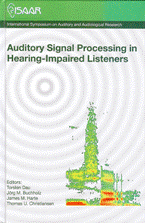Modeling auditory signal processing in hearing-impaired listeners
Abstract
Recently, an auditory signal processing model was developed which can sim- ulate psychoacoustic data from a large variety of conditions related to spectral and temporal masking in normal-hearing listeners (Jepsen et al., 2008). The model includes the dual-resonance non-linear (DRNL) filterbank suggested by Lopez-Poveda and Meddis (2001) to simulate the non-linear cochlear signal processing, and is otherwise similar to the modulation lterbank model by Dau et al. (1997). In the present study, the model parameters were modi ed to sim- ulate cochlear hearing impairment. The modi cations of the model were based on individual data from notched-noise masking and forward masking and were associated with changes of the parameters of the DRNL stage of the model. Data from a pure-tone audiogram were used to further reduce listener sensitivity in connection with an assumed loss of inner hair cells. In addition, intensity discrimination experiments and a modulation depth discrimination experiment were performed to estimate potential retro-cochlear (central) limitations of the processing of supra-threshold stimuli. The model helps understanding the perceptual consequences of hearing impairment in individual listeners and might be useful for the evaluation of hearing-aid signal processing.
References
Ewert, S. D., and Dau, T. (2004). “External and internal limitations in amplitude modulation processing,” J. Acoust. Soc. Am. 116, 478-490.
Jepsen, M. L., Ewert, S. D., and Dau, T. (2007), “Modeling spectral and temporal masking in the human auditory system,” J. Acoust. Soc. Am., accepted.
Kohlrausch, A., Fassel, R., and Dau, T. (2000). “The influence of carrier level and frequency on modulation and beat-detection thresholds for sinusoidal carriers,” J. Acoust. Soc. Am. 108, 723-734.
Lopez-Poveda, E. A., and Meddis, R. (2001). “A human nonlinear cochlear lter- bank,” J. Acoust. Soc. Am. 110, 3107–3118.
Muller M., Robertson D., and Yates G. K. (1991). “Rate-versus-level functions of primary auditory nerve fibres: evidence for square law behaviour of all fibre categories in the guinea pig,” Hear. Res. 55, 50–56.
Oxenham, A., and Plack, C. (1997). “A behavioral measure of basilar-membrane non- linearity in listeners with normal and impaired hearing,” J. Acoust. Soc. Am. 101, 3666-3675
Plack C. J., and Oxenham A. J. (2000). “Basilar-membrane nonlinearity estimated by pulsation threshold,” J. Acoust. Soc. Am. 107, 501–507.
Rosen, S., Baker, R. J., and Darling, A. (1998). “Auditory filter nonlinearity at 2 kHz in normal hearing listeners,” J. Acoust. Soc. Am. 103, 2539-2550.
Rosengard, P.S., Oxenham, A.J., and Braida, L.D. (2005). “Comparing different estimates of cochlear compression in listeners with normal and impaired hearing,” J. Acoust. Soc. Am. 117, 3028-3041
Additional Files
Published
How to Cite
Issue
Section
License
Authors who publish with this journal agree to the following terms:
a. Authors retain copyright* and grant the journal right of first publication with the work simultaneously licensed under a Creative Commons Attribution License that allows others to share the work with an acknowledgement of the work's authorship and initial publication in this journal.
b. Authors are able to enter into separate, additional contractual arrangements for the non-exclusive distribution of the journal's published version of the work (e.g., post it to an institutional repository or publish it in a book), with an acknowledgement of its initial publication in this journal.
c. Authors are permitted and encouraged to post their work online (e.g., in institutional repositories or on their website) prior to and during the submission process, as it can lead to productive exchanges, as well as earlier and greater citation of published work (See The Effect of Open Access).
*From the 2017 issue onward. The Danavox Jubilee Foundation owns the copyright of all articles published in the 1969-2015 issues. However, authors are still allowed to share the work with an acknowledgement of the work's authorship and initial publication in this journal.


